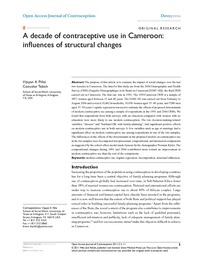
ATTENTION: The works hosted here are being migrated to a new repository that will consolidate resources, improve discoverability, and better show UTA's research impact on the global community. We will update authors as the migration progresses. Please see MavMatrix for more information.
Show simple item record
| dc.contributor.author | Pillai, Vijayan K. | |
| dc.contributor.author | Teboh, Consoler | |
| dc.date.accessioned | 2012-05-02T20:35:58Z | |
| dc.date.available | 2012-05-02T20:35:58Z | |
| dc.date.issued | 2010-12-22 | |
| dc.identifier.citation | Published in Open Access Journal of Contraception. | en_US |
| dc.identifier.issn | 0099-4537 | |
| dc.identifier.uri | http://hdl.handle.net/10106/9688 | |
| dc.description.abstract | The purpose of this article is to examine the impact of social changes over the last two decades in Cameroon. The data for this study are from the 2004 Demographic and Health Survey (DHS) (Enquête Démographique et de Santé au Cameroun [EDSC-III]), the third DHS carried out in Cameroon. The first one was in 1991. The 1991Cameroon DHS is a sample of 3871 women aged between 15 and 49 years. The EDSC-III was carried out from February to August 2004 and covered 10,462 households, 10,656 women aged 15–49 years, and 5280 men aged 15–59 years. Logistic regression was used to estimate the effects of proposed determinants of modern contraceptive use among a sample of respondents in the 1991 and 2004 DHSs. We found that respondents from both surveys with an education compared with women with no education were more likely to use modern contraception. The two decision-making-related variables, “discuss” and “husband OK with family planning”, had significant positive effects on modern contraceptive use in both surveys. A few variables such as age at marriage had a significant effect on modern contraceptive use among respondents in one of the two samples. The differences in the effects of the determinants in the proposed models on contraceptive use in the two samples were decomposed into processual, compositional, and interaction components as suggested by the cohort effect model made famous by the demographer Norman Ryder. The compositional changes during 1991 and 2004 contributed more toward an improvement in modern contraceptive use than the rest of the components. | en_US |
| dc.language.iso | en_US | en_US |
| dc.publisher | Dove Press | en_US |
| dc.subject | modern contraceptive use | en_US |
| dc.subject | logistic regression | en_US |
| dc.subject | decomposition | en_US |
| dc.subject | structural influences | en_US |
| dc.title | A decade of contraceptive use in Cameroon: influences of structural changes. | en_US |
| dc.type | Article | en_US |
| dc.identifier.externalLinkDescription | The original publication is available at Article DOI. | en_US |
| dc.identifier.doi | http://dx.doi.org/10.2147/OAJC.S12621 | |
Files in this item
- Name:
- OAJC-12621-a-decade-of-contrac ...
- Size:
- 207.4Kb
- Format:
- PDF
- Description:
- PDF
This item appears in the following Collection(s)
Show simple item record


